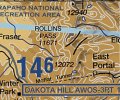Why both? Why put primer and paint on you airplane? The two do not provide the same service. And flight following can be canceled due to workload or other issues.
Victor 3 southbound, weekend before Easter. 3 hour leg into Savanah, with a VFR flight plan with the FSS system. About half way on that leg, flight following canceled due to to many IFR planes in the combined V3 and V1 routes, that are converging.
Arrived at SAV in drizzling rain, but good VFR, to be greeted by a line boy in slicker, and thrilled to see us. Go straight to the office, call FSS, they have started a search for you! He had just finished checking every plane in the tiedown area for our number. In the office, the manager dialed the number, and when FSS answered, they were very happy to hear from me. I was 55 minutes late, and they had called airports all along my flight plan to see if we might be there.
The feared accident turned out to be theirs, the teletype message to SAV FSS had 2 hours instead of my filed 3 hours. When we arrived, they were 55 minutes into a mostly telephone search, and at an hour, planned to consider a call to the Civil Air Patrol, which was much more active then. He admitted he was embarrassed that he had not considered that no Cessna 172 would have flown 300 miles in 2 hours.
If you stop responding to Flight Following, they do not start a search, unless they noticed your altitude went below radar coverage.
3 crashes within a quarter mile of College Park Airport, MD, went into soft treetops, and had no locator beacon activation. In the cell phone world, with at least one in condition to dial 911, they would have been rescued quickly, but out in the boonies, not much chance.
Extra layers of protection, with overlapping functions, plus the ELT make a bad injury accident more likely to be survived. And there is no extra charge for the flight plan.



